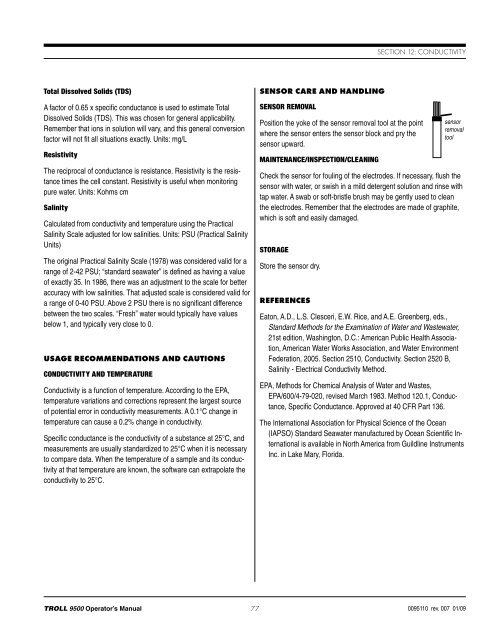TROLL 9500 Operator's Manual - Geotech Environmental Equipment
TROLL 9500 Operator's Manual - Geotech Environmental Equipment
TROLL 9500 Operator's Manual - Geotech Environmental Equipment
Create successful ePaper yourself
Turn your PDF publications into a flip-book with our unique Google optimized e-Paper software.
Section 12: ConductivityTotal Dissolved Solids (TDS)A factor of 0.65 x specific conductance is used to estimate TotalDissolved Solids (TDS). This was chosen for general applicability.Remember that ions in solution will vary, and this general conversionfactor will not fit all situations exactly. Units: mg/LResistivityThe reciprocal of conductance is resistance. Resistivity is the resistancetimes the cell constant. Resistivity is useful when monitoringpure water. Units: Kohms cmSalinityCalculated from conductivity and temperature using the PracticalSalinity Scale adjusted for low salinities. Units: PSU (Practical SalinityUnits)The original Practical Salinity Scale (1978) was considered valid for arange of 2-42 PSU; “standard seawater” is defined as having a valueof exactly 35. In 1986, there was an adjustment to the scale for betteraccuracy with low salinities. That adjusted scale is considered valid fora range of 0-40 PSU. Above 2 PSU there is no significant differencebetween the two scales. “Fresh” water would typically have valuesbelow 1, and typically very close to 0.Usage Recommendations and CautionsConductivity and TemperatureConductivity is a function of temperature. According to the EPA,temperature variations and corrections represent the largest sourceof potential error in conductivity measurements. A 0.1°C change intemperature can cause a 0.2% change in conductivity.Specific conductance is the conductivity of a substance at 25°C, andmeasurements are usually standardized to 25°C when it is necessaryto compare data. When the temperature of a sample and its conductivityat that temperature are known, the software can extrapolate theconductivity to 25°C.Sensor Care and HandlingSensor RemovalPosition the yoke of the sensor removal tool at the pointwhere the sensor enters the sensor block and pry thesensor upward.Maintenance/Inspection/CleaningsensorremovaltoolCheck the sensor for fouling of the electrodes. If necessary, flush thesensor with water, or swish in a mild detergent solution and rinse withtap water. A swab or soft-bristle brush may be gently used to cleanthe electrodes. Remember that the electrodes are made of graphite,which is soft and easily damaged.StorageStore the sensor dry.ReferencesEaton, A.D., L.S. Clesceri, E.W. Rice, and A.E. Greenberg, eds.,Standard Methods for the Examination of Water and Wastewater,21st edition, Washington, D.C.: American Public Health Association,American Water Works Association, and Water EnvironmentFederation, 2005. Section 2510, Conductivity. Section 2520 B,Salinity - Electrical Conductivity Method.EPA, Methods for Chemical Analysis of Water and Wastes,EPA/600/4-79-020, revised March 1983. Method 120.1, Conductance,Specific Conductance. Approved at 40 CFR Part 136.The International Association for Physical Science of the Ocean(IAPSO) Standard Seawater manufactured by Ocean Scientific Internationalis available in North America from Guildline InstrumentsInc. in Lake Mary, Florida.<strong>TROLL</strong> <strong>9500</strong> Operator’s <strong>Manual</strong> 770095110 rev. 007 01/09
















